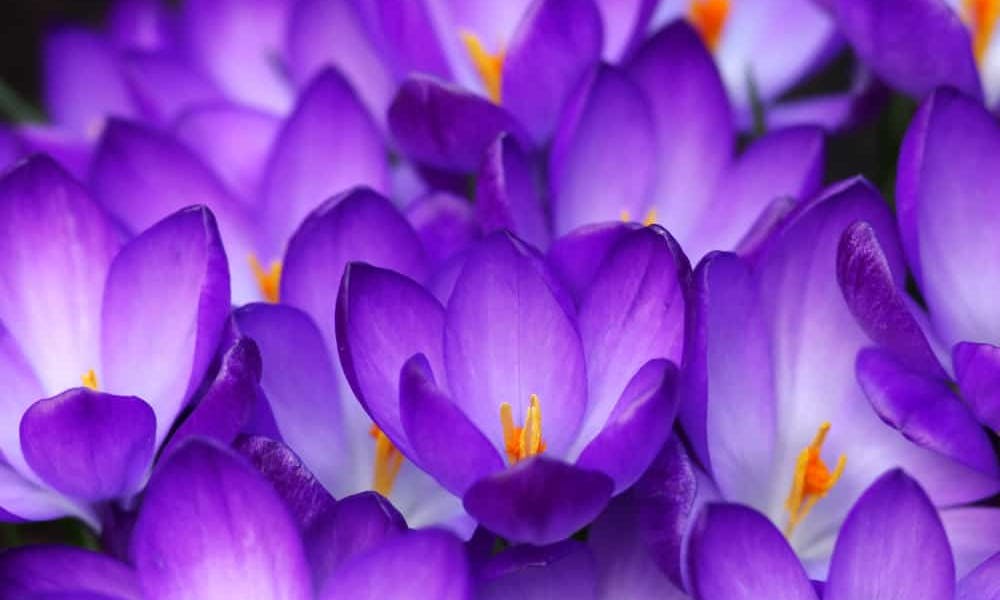The beautiful crocus flower, not to be confused with the autumn crocus of the Lily family, is a sight for sore eyes found in gardens throughout the world. Often one of the first flowers to bloom in the spring season, the colorful crocus has sometimes been referred to as the lightbulb flower as its glowing yellow petals look like a lightbulb when closed until they unfurl into their well-known cup-like shape. Its bright, festive exterior is a cheerful addition to all gardens and landscapes looking to bring some much-needed color to our grey, colorless city lives.
We are going to explore all there is to know about this wonderful flower.
Keep on reading to find out the:
- Origins of the Crocus Flower
- Crocus Flower Specs
- Culture, Symbolism, and Myth
- Saffron Craziness
- Cuisine and Medicinal Uses
- Crocus Planting and Care
Origins of the Crocus Flower
The crocus is a member of the Iris family of flowering plants. This genus, containing some 90 species of plants, is most famous for its saffron producing variety, the crocus sativus. Crocuses can be found in many parts of the world, with species growing in North Africa, the Middle East, around Europe; most notably in Greece and Spain, all the way to parts of China. Native to the meadows and woodlands, this hardy plant is a perennial and can last for many years in the right conditions. As early as the 17th century, new varieties were being produced around the world as the flowers were brought over by ambassadors and explorers.
Crocus Flower Specs
The cup-shaped crocus is a part of a colorful genus, with not only white petals but others such as lilac, mauve, blue, orange, yellow, and lavender. The crocus produces corms, bulb-like roots that take the place of seeds for its reproduction. They are a solitary plant, preferring space for growth. The leaves are ensiform, resembling grass. Each leaf generally contains a stripe, white in color, along its central axis. Most crocus flowers have three stamens, with only a single style. Some of the flowers can bloom as early as January in warmer climates, but most tend to bloom in the early spring. The petals of the crocus only open on sunny days, remaining closed in a protective huddle to conserve energy at other times.
Culture, Symbolism, and Myth
The name crocus is thought to stem from the Greek name Krokus, who was a young man who fell in love with a nymph named Smilax and had an affair. Unhappy with the state of the relationship, Krokus complained, and was turned into a flower by the gods. Other stories say that Smilax was a shepherdess, and after being refused by the gods for her hand in marriage, Krokus took his own life. The goddess, Flora, was moved by the sadness of Smilax and turned them both into flowers. The white crocus has come to symbolize purity, innocence, and truth. The purple is often connected with dignity and success, while the yellow is thought to symbolize cheerfulness and joy. In ancient Rome, the flower was believed to inspire love and was sprayed onto guests when they arrived at events.
Saffron Craziness
Stemming from the crocus sativas, saffron is the world’s most expensive food item, being sold at $2,000 to $10,000 dollars a pound! It is extremely labor-intensive to pick, with a single flower only producing three stigmas each, and each ounce of saffron containing close to 14,000 stigmas. The flowers only bloom for a few days once a year, so you can imagine the difficulty in getting the quantity needed to supply the world. Most of the world’s saffron is grown in a single area of Spain known as Castilla-La Mancha. It can also be found in areas of Iran, although it is considered of lesser quality, with the Spanish variety being sold at nearly double the price generally.
Cuisine and Medicinal Uses
Many of the crocus species corms are edible, being cooked and eaten much the same as chestnuts or hazelnuts. They are a starchy, tuber-like food, dense in calories. The most famous use in cuisine is of the saffron spice. Only a tiny amount is required in cooking, as saffron is very potent; adding a pinch to stews, soups, and marinades for beef and seafood goes a long way. It is also quite popular in risottos and other rice dishes. The stigmas of saffron, and sometimes the petals, are used medicinally as well. Some research has shown benefits for menstrual issues such as cramps and irregularities, whereas men have been known to use it for infertility. Some signs of benefit for Alzheimer’s and depression have also been found.
Crocus Planting and Care
Quite easy to raise, the crocus flower can be a good addition to most gardens. The plants require full sunlight or partial shade. Good well-drained soil is ideal, with the corm being planted about 3 inches deep before the cold sets in. Give at least 2 inches of space between it and other plants. A good bulb fertilizer applied in the fall season helps to keep them healthy and strong year-round. Replanting every few years is a good idea, to clear away unhealthy corms that have taken root. They are a good fit for most flower beds and can survive quite well in containers indoors.
A Lovely Partner
Whether you are simply looking to add some more beautiful colors to your garden or the indoors, the crocus flower is a good choice. With the prices of saffron being so high, investing in a crocus sativa flower and having fresh saffron available for yourself, as well as some tasty corms to roast through the winter months, can be a fun and lasting partnership to take part in.
